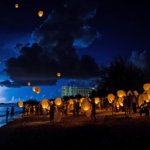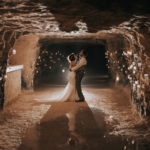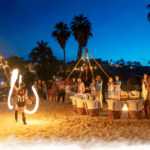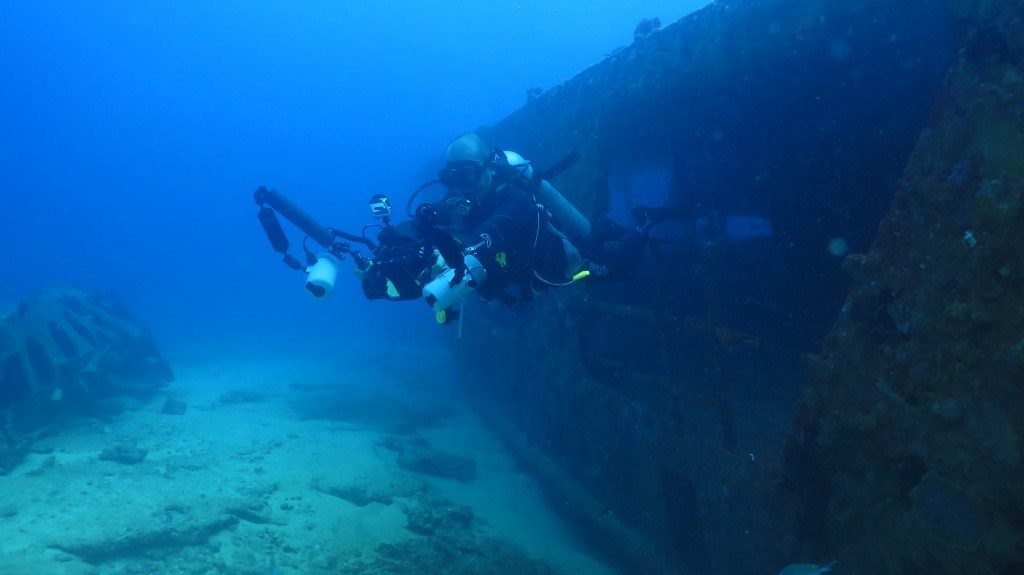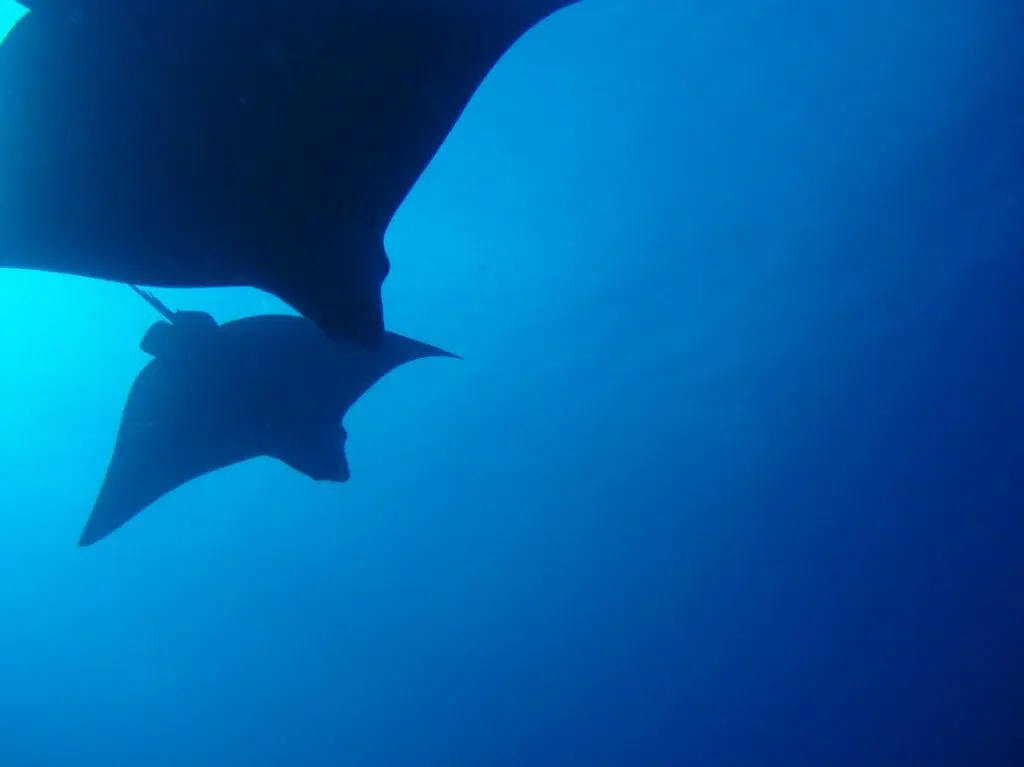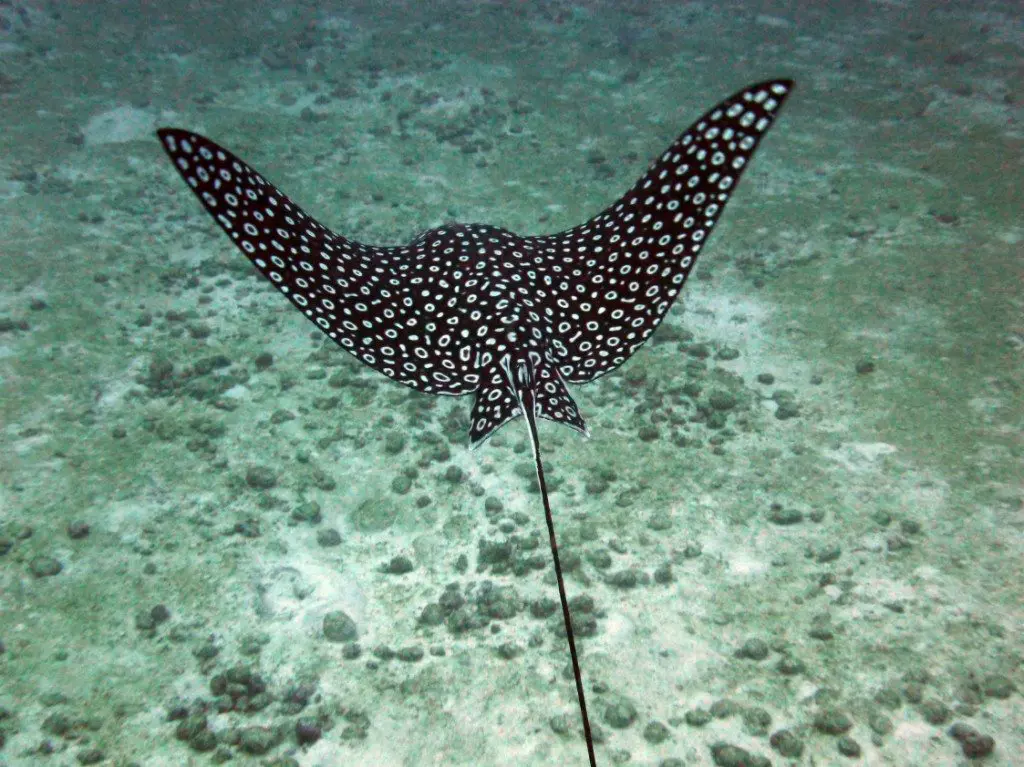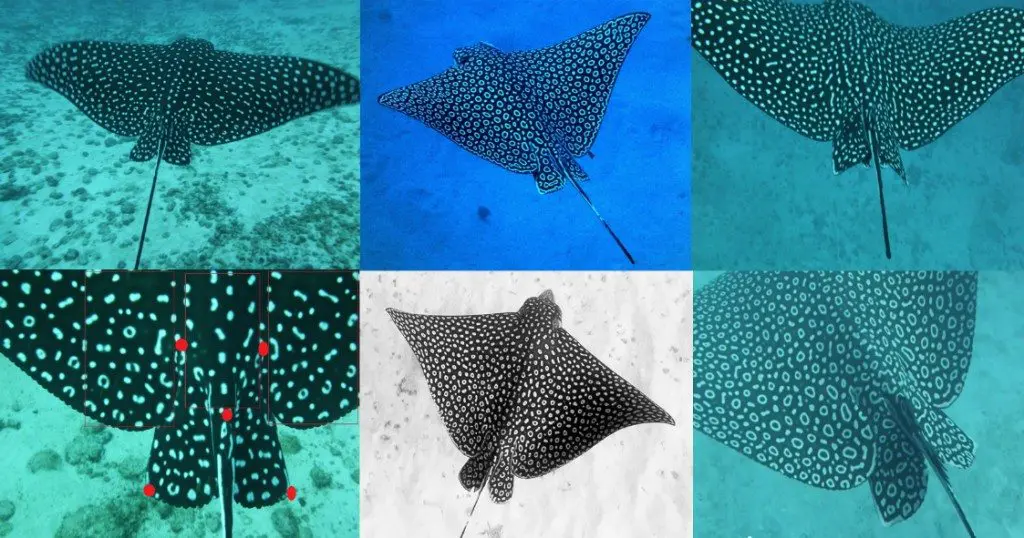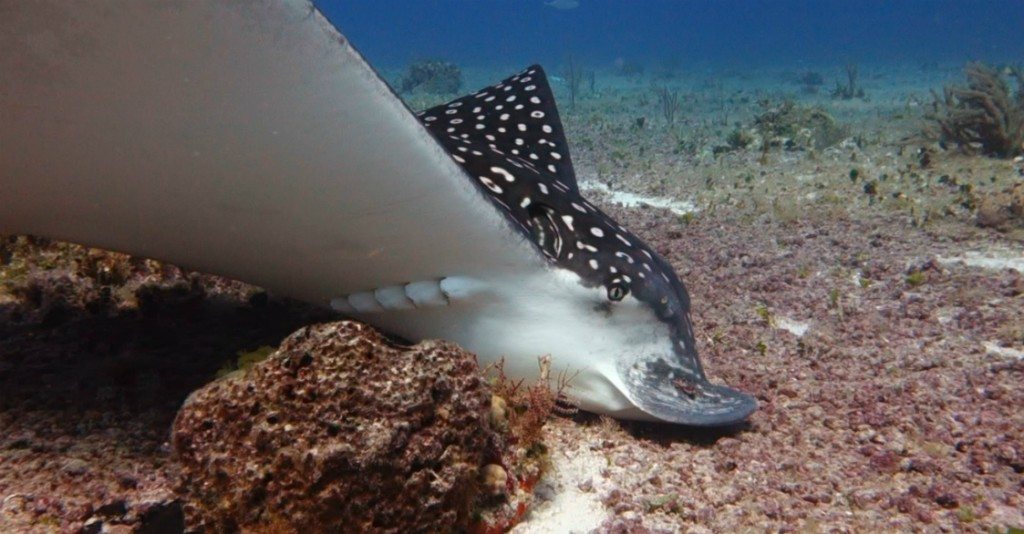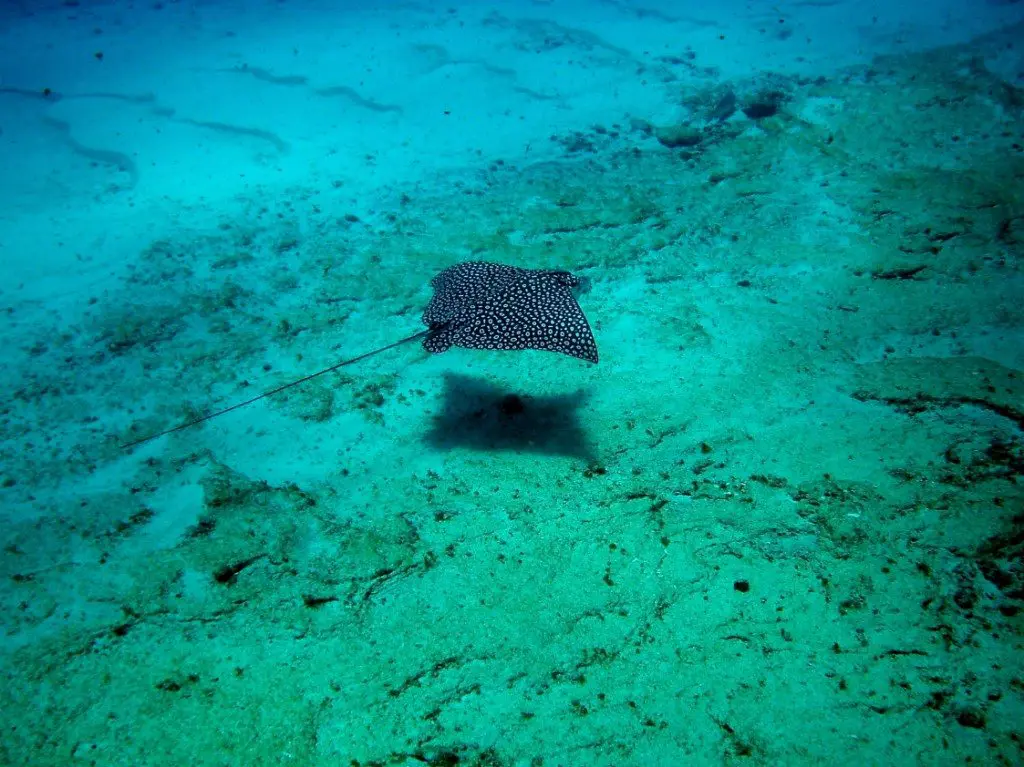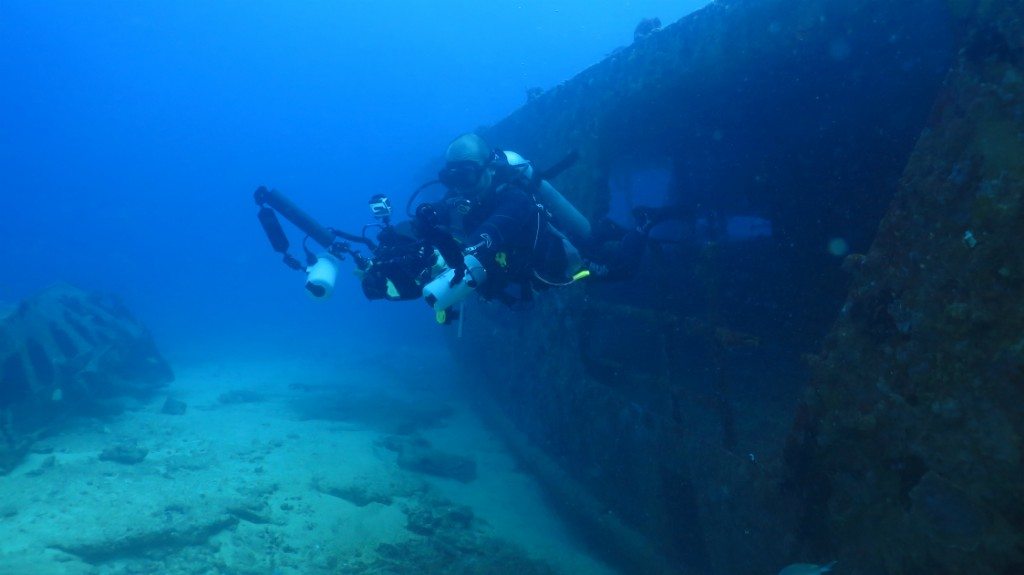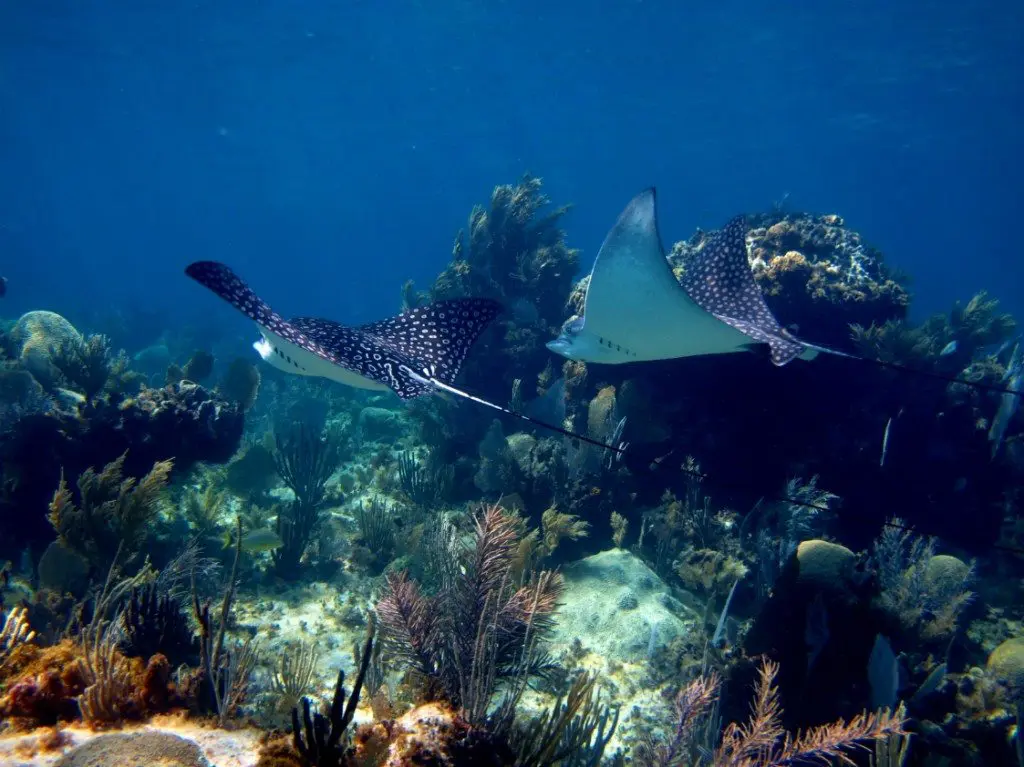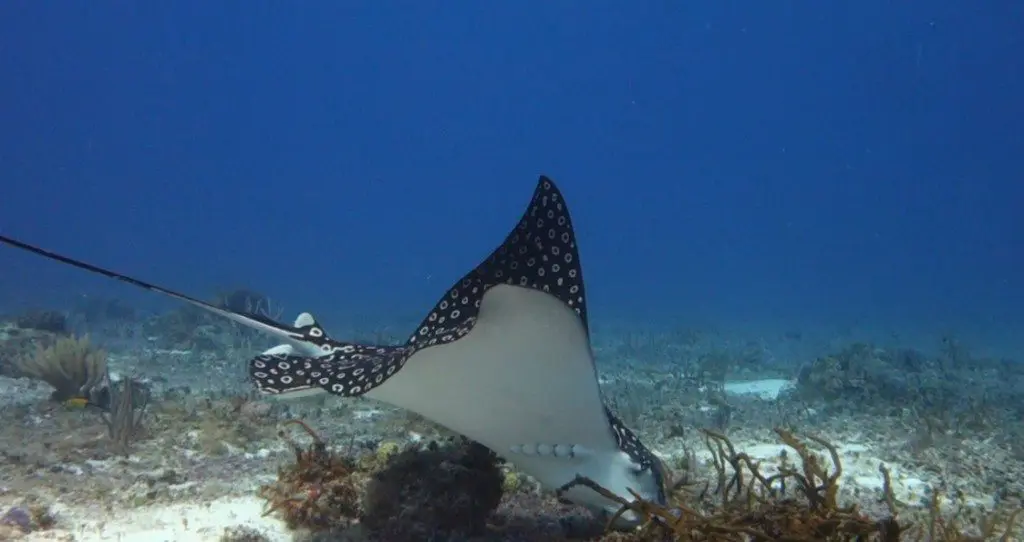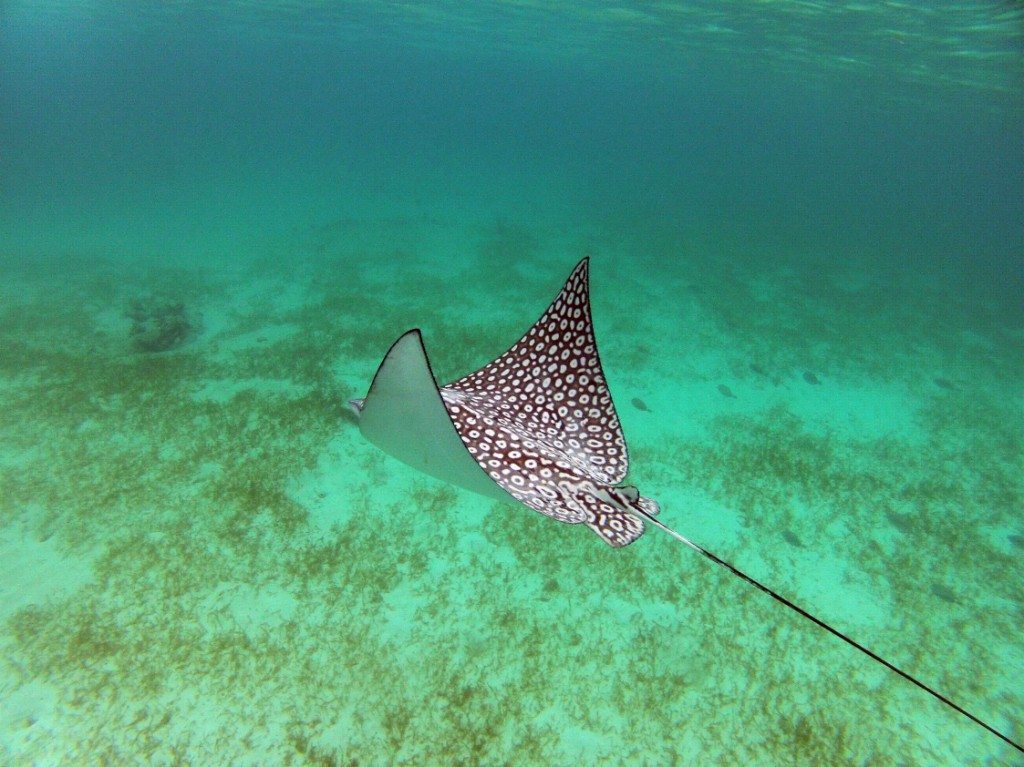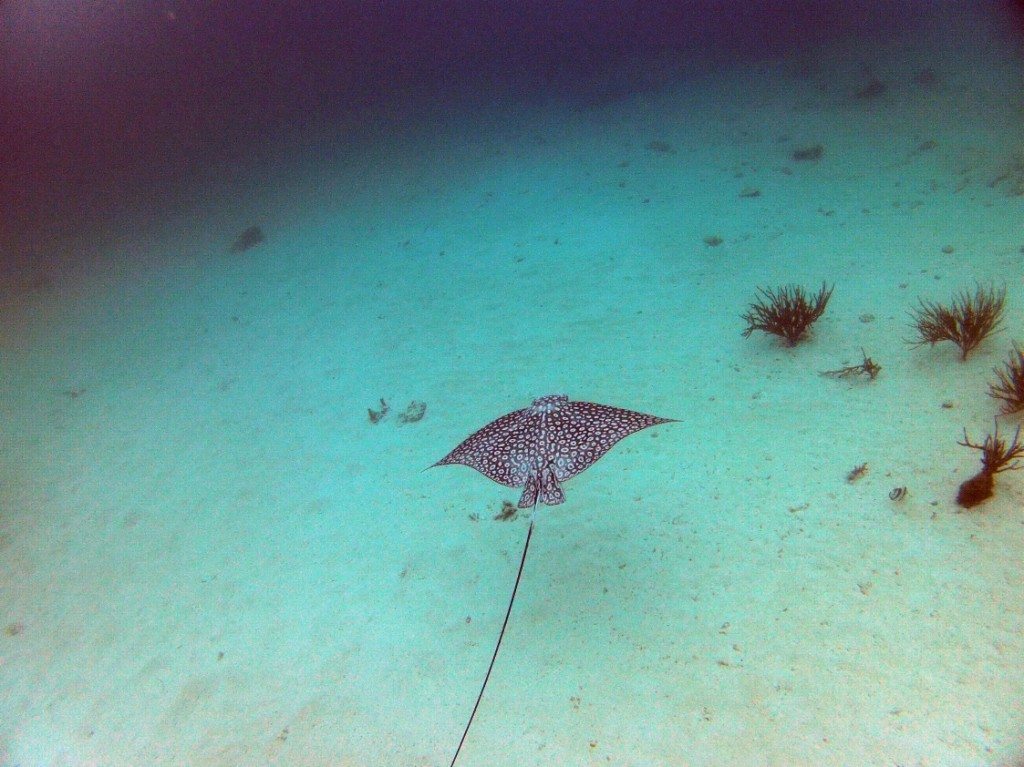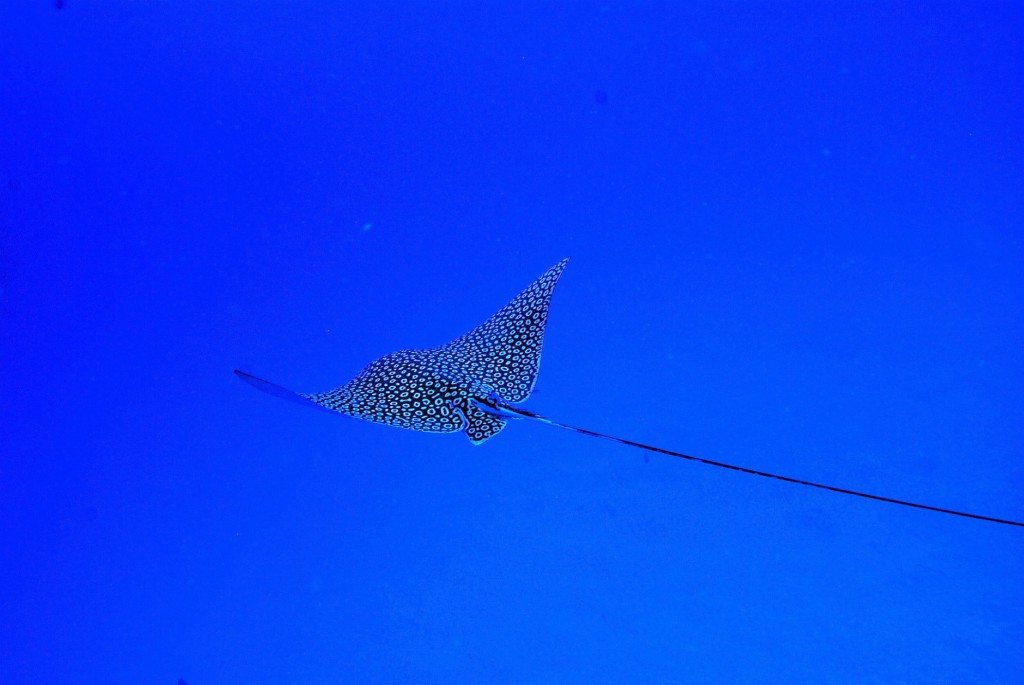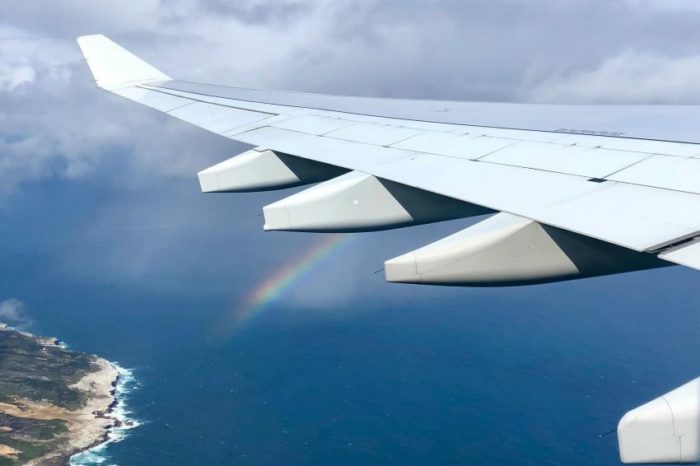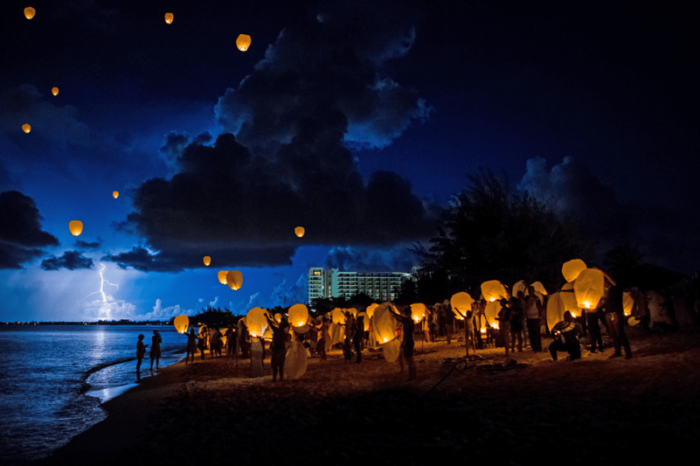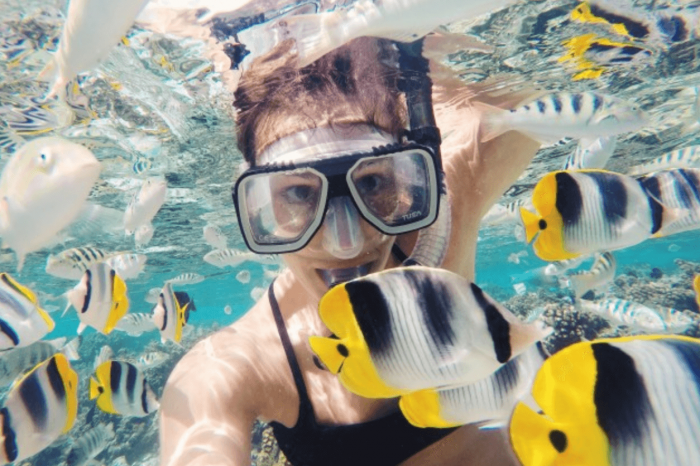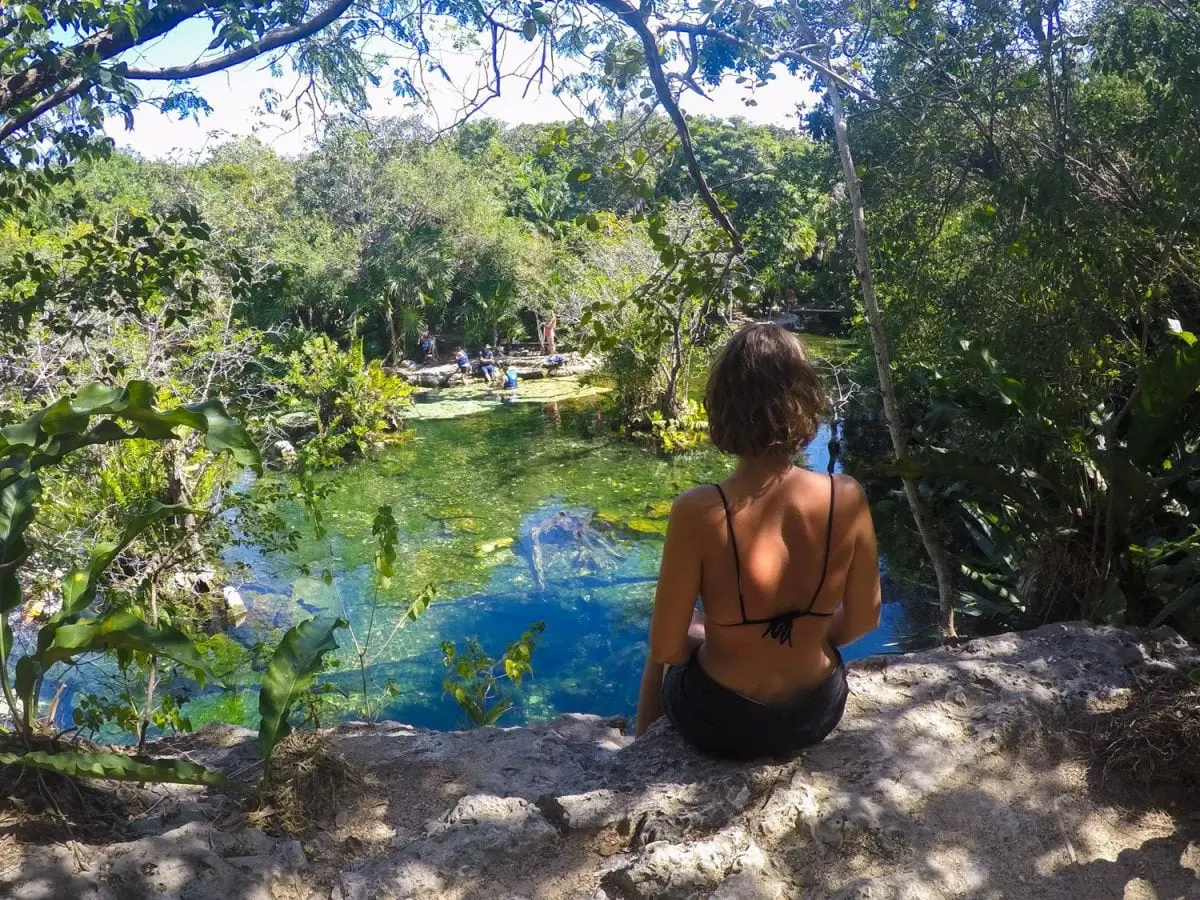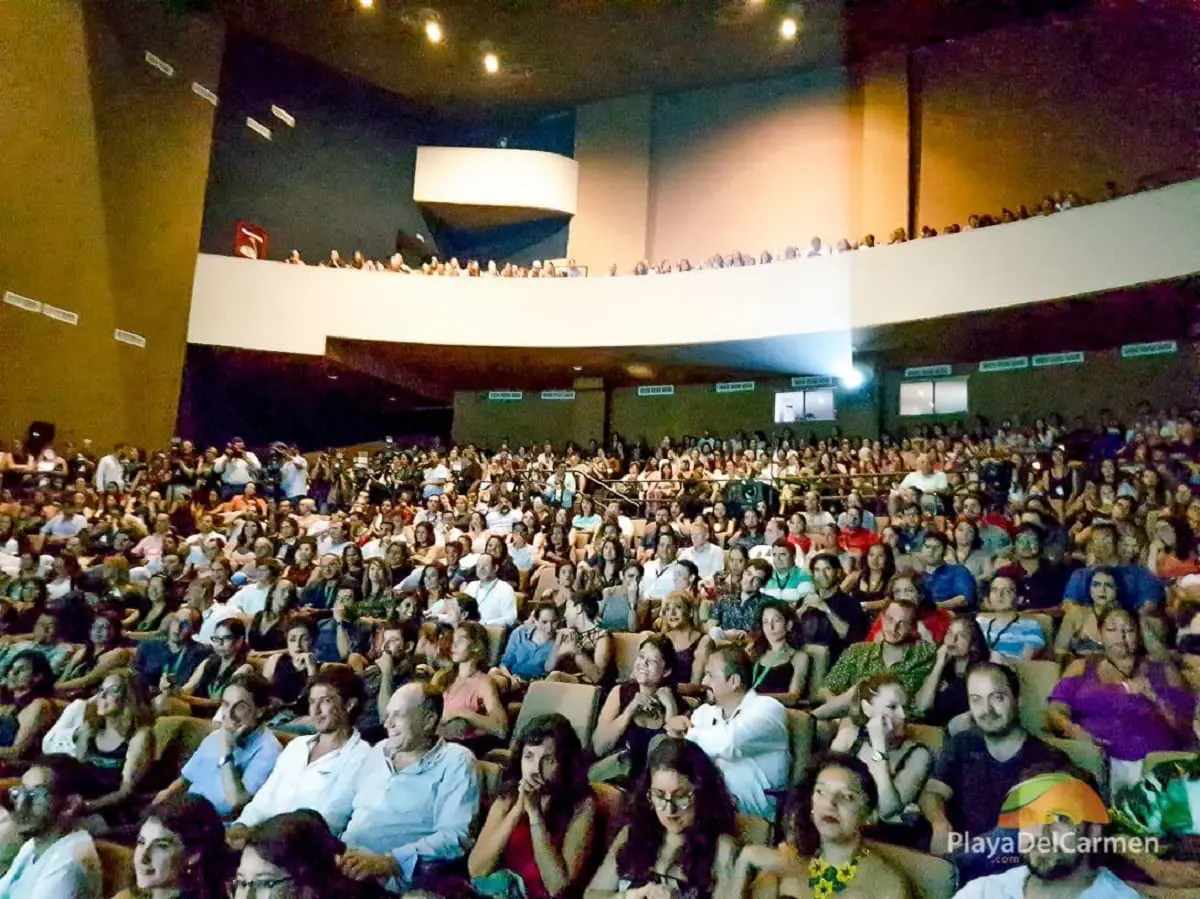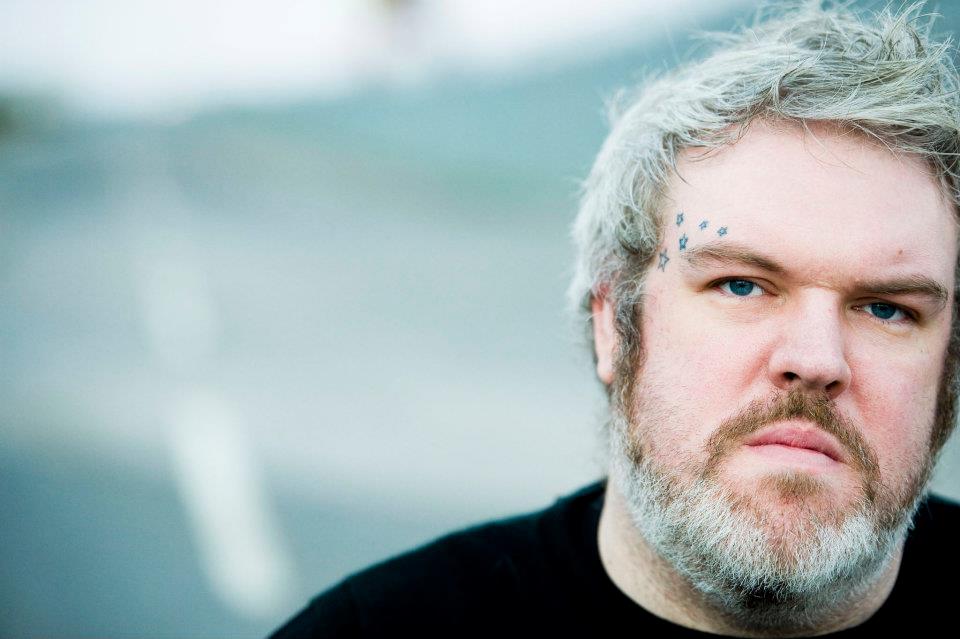Spotted Eagle Ray Conservation in Playa del Carmen
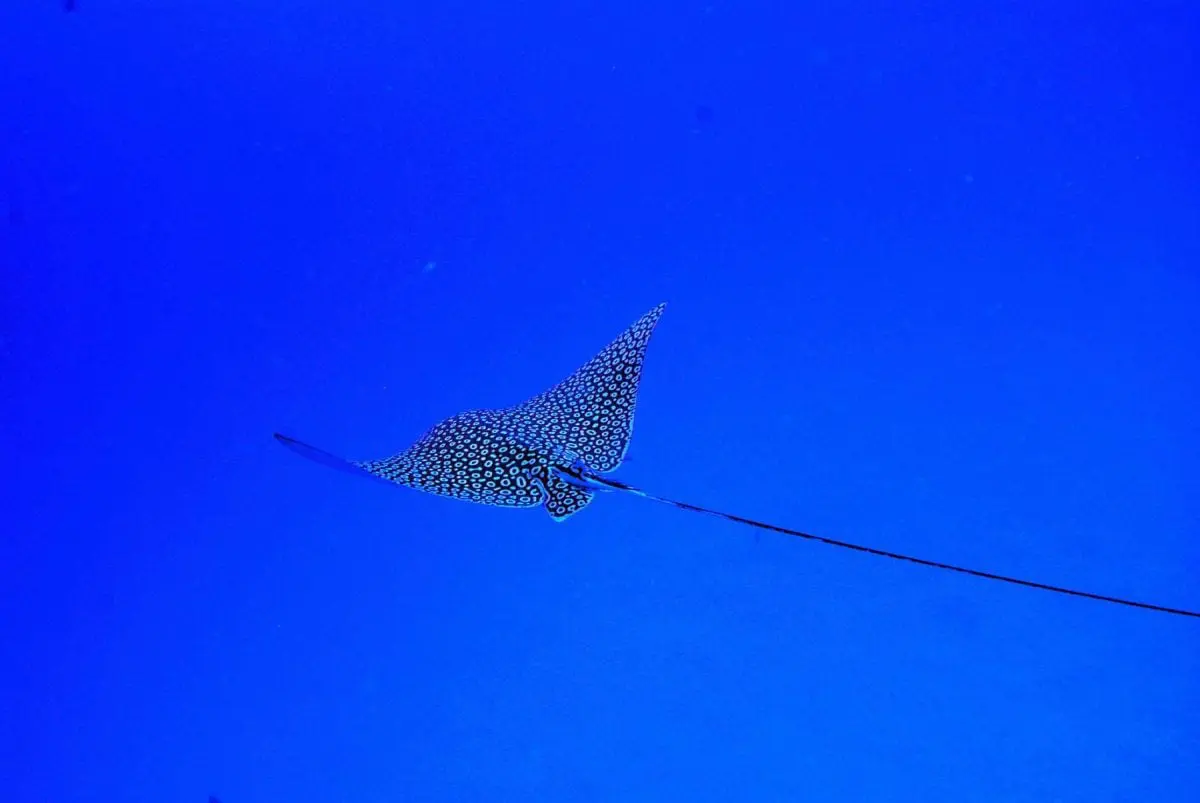
Young, passionate and blue. Those are the words that Ximena Arvizu and Florencia Cerutti use to describe their organization, Blue Core A.C. A group of women dedicated to playing their part to protect our ocean and the living organisms that call 70% of our planet their home founded the NGO in 2015. Their primary focus is the study and documentation of Spotted Eagle Rays in the region comprised of the Mexican Caribbean (Cancun, Puerto Morelos, Playa del Carmen, Cozumel, etc.).
Like another local attraction and seasonal cash cow, the whale shark, little is known about these graceful creatures. What are their migratory patterns? Why do they come and go when they do? Do the same Spotted Eagle Rays always return or do they vary according to season?
These are just some of the questions that this passionate group of scientists and conservations are investigating. By producing information to get a better understanding of these spotted wonders of the natural world, more can be done to protect them and their habitat in the future.
Towards the end of the Spotted Eagle Ray season, we caught up with Ximena Arvizu and Florencia Cerutti for an interview at Ah Cacao on Playa’s famous Fifth Avenue. Here’s what they do and how you can support them.
First of all, why Spotted Eagle Rays?
Ximena Arvizu: Well, because we love them. We have seen them while diving and we fell in love with the species. We started out by joining a project with another scientist from Mote Marine Lab in Florida. She has been studying Spotted Eagle Rays for about five years, but then we came back here and we wanted to start something similar in Quintana Roo. We realized that we needed something else and we have a really good friend that’s an expert in sharks, and he said, “Hey, I’ve got a friend that is an expert in rays, and she’s right here in Playa del Carmen.” And we were like, “No way! We need to meet her!” It was love at first sight! A match made in heaven for the rays, us and Flor. We were like, “We need you, Flor!” So we told her about the project, what we were starting, what we wanted to do with the project and she was like, “Yeah, I’m in! I love it!” And, well, she’s always been in love with rays and sharks but I’ll let Flor tell her story.
Florencia Cerutti: Blue Core was founded because of the love for Spotted Eagle Rays and because of the realization that we need to start protecting our marine resources. I started studying rays many years ago, and Spotted Eagle Rays are important in the world economy primarily because they are fished—overfished would be more correct. So they are fished all over the place because they are an important source of proteins for coastal communities. Likewise, rays in general and of course Spotted Eagle Rays are important for tourism because they gather in large numbers at key SCUBA diving locations here. These factors convinced me to start studying rays and that’s why I joined this project. They are beautiful animals, and they are also important for this area.
Who is Blue Core and what is your mission?
Florencia: Blue Core is a non-profit environmental NGO. It started last year in 2015, and right now we are a team of about 4 to 5 people. We all come from different backgrounds, and some just volunteer their time. We’re all passionate and concerned about the same topics. We care about the ocean and we want to do something for our marine resources and the oceans.
Ximena: It’s important to mention that Blue Core started as a group of young Mexican women who are passionate about the environment. Some of us studied overseas, but we came back with a goal in mind of conservation, love for our planet and love for our country and what we have here. So, yeah, Blue Core is a young, passionate and blue organization started up by women. I think that’s very important.
How much is known about the Spotted Eagle Rays?
Florencia: Pretty much nothing. In general I think the group of sharks and rays is quite unknown and misunderstood. This ray in particular is famous all over the world because it’s beautiful, so it’s famous for snorkeling, diving, and also in fisheries, but there’s very little real data. In addition, most of the information that does exist comes from fisheries.
Ximena: It’s kind of like with the whale sharks. People love them and they know they’re there, and when they come people go see them, but they don’t know where they go or how many there are. There are a lot of unknowns and most of what is known comes from fisheries or tour operators and from the little that they’ve had the chance to see when they’re diving or snorkeling with them. But they don’t really know where they go or their migratory patterns.
What makes the Spotted Eagle Rays unique?
Florencia: They’re beautiful! They are unique because they are an important part of the ecosystem and food chain. They are both prey and predators, and both are important in order to keep our ecosystem and reefs healthy. Also they’re unique because they are an important source of protein, so they’re important for communities, too. In addition, their spot patterns are unique to each individual just like our fingerprints. Plus, there was also a Spotted Eagle Ray in Finding Nemo, so they’re stars!
How and what do they eat?
Ximena: They have sensors in their snouts that they use to find their prey. Imagine like when you go to the beach with a metal detector and scan for things. It’s very similar, and that’s what they use to scan for mollusks and crabs; whatever is delicious and stuffed inside a shell—hard on the outside, soft on the inside! Once they find their food, they use their snout as a shovel, dig it up and then they crush it. They have extremely strong palates to crush their prey and then they spit out all of the little pieces and eat what’s left on the inside.
Where can Spotted Eagle Rays be found?
Florencia: Spotted Eagle Rays can be found in tropical and sub-tropical waters. They are considered to be a reef species. So they can be found around reefs, because their main prey items are reef species. They can be found in deep waters, but you can also see them as a diver in shallow water, less than 30 feet. They tend to hang out a lot where there are strong currents, likely because they use less effort to breathe by allowing the current to flow the water through their systems. So it’s very common to find them where there are strong currents.
Ximena: Here in Playa del Carmen they can be found at some of the reefs. In Cancun and Puerto Morelos it’s common to see them around the shipwrecks. In Cozumel there’s a very popular place for divers that goes specifically to see eagle rays. We’re still trying to investigate some other places that we’ve heard about but still have no concrete data.
What level of PADI certification do you need to dive in the spots where you can find Spotted Eagle Rays?
Florencia: Well, you need to be advanced. If it were open water then with good advanced skills. This is because with open water you can’t go further than 18 meters and if you have only done the course then you’re not trained to deal with currents and the depths where the shipwrecks are here. So usually what we ask is not so much the certification but the experience. If you’re comfortable with currents and deep dives and shipwrecks then you will be fine.
Ximena: But you have to be certified to come with us and comfortable with currents, because it’s a bit of a stressful dive, not a chill-out dive. There are currents and you have to fight them to stay where you want to stay and so it’s not an easy dive. But snorkelers can see them in shallower reefs as well in Puerto Morelos.
What don’t we know about the Spotted Eagle Ray?
Florencia: So much. For example, the things we are looking into involve topics like migrations, movements and their populations. We have them only in winter here, that’s it. We don’t know why they come, why they go. We don’t know if they’re the same groups that come at the start of December and then leave or if it there are different groups coming. So pretty much nothing is known about their movements. But there are also a few other things, like for instance we don’t know where they mate, we don’t know where they give birth. We don’t know what impact climate change could have on them. We don’t know how much they are fished here in this area. So there are many, many questions.
Ximena: We don’t really know what kind of species they are eating when they come to Mexico. We still don’t know that. Our colleagues are studying it in a research center in Campeche, but that is the Gulf of Mexico and we don’t know what type of species they are feeding on in the Mexican Caribbean. It’s essential to understand because often their main food source is the Queen Conch, which is being seriously overfished here. So if that’s their main prey here then we’re in trouble. Big trouble. So we are still trying to figure all that stuff out.
What can we learn about ourselves as human beings by studying the Spotted Eagle Ray?
Florencia: How beautiful and unique we are all! Actually, this is something that we are also trying to work with, because if we can establish a link between humans and eagle rays then there is more likelihood that we’ll protect them.
Ximena: I think you only take care of what you love and you love what you know. We are scientists and conservationists and we’ve always tried to take care of the ocean, but if we tried to take care of the whole ocean maybe we’d lose track a little bit. So we are starting with one species that we’re passionate about, and maybe by letting people know about the Spotted Eagle Ray and getting to love it as we do maybe we can start taking better care of the ocean in general.
Florencia: And to raise awareness not only about the rays, but also about the fact that they are related to sharks, about the impacts of what we do, for instance how what we eat has an impact on our environment. In fact, most people don’t even know that we eat them. Once they find out they say, “Why do you eat it!” But there are people and fishing communities that do eat them. They’re prey for us humans. So raising awareness is a big thing as well in this project.
So you’re learning about this species in an environment that is being affected by global warming. What effects are you seeing on their habitat in this region of the Caribbean or the Gulf of Mexico?
Florencia: I think in this region it’s a little hard to separate the effects of global warming from the effects of excessive, unregulated tourism. I think they are closely linked in this area of the world, and I don’t think they can be easily separated, because the biggest impact on our resources here is from tourism and the ridiculous amounts of growth and urbanization. Furthermore, climate change is not an isolated issue; it’s complex and it has a lot of factors that influence it. While in some places you can find cases of coral bleaching, here, for example, we may see more of a transition from a coral reef to a seaweed reef than coral bleaching. And that may happen when you eliminate the species that eat seaweed off a coral reef system. So nobody eats the seaweed and therefore the seaweed reproduces. And there is also the run-off of nutrients from land. So it’s a combination of things. I think with an appropriate study on climate change what we may see here more is the effects of unregulated, massive development.
Ximena: We’ve heard, we are not sure, we have heard that they used to see way more eagle rays than we see right now, but we don’t have evidence for that. So is it true? Is it not true? How many did they used to see? They say they used to see more than 100 at a time, but we don’t know. We don’t have proof. It’s possible that the species is declining, we just don’t have hard evidence.
Who’s more dangerous to whom? Rays to humans or humans to Rays?
Florencia: Every single living organism is generally threated by humans and not the other way around. We only get in danger when we cross lines, which humans always do. Spotted Eagle Rays are the type of animal that will always swim away. There are other rays that stay in the same spot for a long time, and those could be a little bit more harmful if you’re walking and you step on it. And by the way, in such scenarios it’s not the ray attacking you; you are stepping on it. Spotted Eagle Rays are always swimming around, so it’s really, really hard to get an encounter that close that it is dangerous. Sometimes what does happen is that fishermen take them out of the water and then they are in the boat rocking with waves and they get stung sometimes, so they cut off their stingers. If you get close to one then you’re lucky. They’re not dangerous at all. But as with all wildlife, the rule of thumb is to keep some distance and respect their ‘personal space.’
How can people help or get involved?
Florencia: There are a million ways. One way is to check us out on Facebook; give us a like, follow us and share our posts. The more people who know about what we do, the more effective this project will be. If somebody’s a SCUBA diver or a snorkeler and you got photos from this or previous seasons you can send them to us and they will be part of our regional catalogue. Another way is through donations. We are a non-profit NGO, so we do rely on donations for everything to run the project and to work to get everything done. So cash donations are useful, but materials are as well. For instance, we organize educational projects, and we need materials for that. Crayons, paper, markers… But also your time and skills are very useful. We need people to help us with marketing or publishing or writing up grants, things like that. So if you have time and are interested and have a skill you can always join us. Likewise, if you’re a SCUBA diver you can join our expeditions and help us take data. There is a cost, which helps us pay for the dive and also pay for other aspects of the project. Another great way to support Blue Core is through the dive shops, because if they invite us along as a biologist on-board then we get to dive and gather data for free, plus we have the opportunity to talk to people and raise awareness.
Ximena: Going with us on a dive helps conservation in two ways. First, some of the money is going to go straight to the project just to keep it running, and you are going to go not just as a diver but as a citizen scientist. So you are going to have your underwater notepad and you are going to take data, you’ll be asked to help with a specific activity, and to take pictures as well. You become 100% part of the team going to gather data, take pictures, count rays, check currents, etc. We take you to the best spots, and it’s a small group of divers. It’s a maximum of six divers maximum per expedition, which is very cool, because some of the shops will take 10 to 15 divers a go. So because it’s a small group and you’re going to collect data about the rays so you can be more prepared, more careful about how to approach them, how to take their pictures. Plus, we get to leave at a privileged time quite early in the morning before any other divers go, so you get to be there first. We often see groups of 30 or more at a time. You may not see as many if you go later. Ximena: I think we really need people to help us out with other skills or ideas. Ideas to raise more money. Some people are really good with blogging, design or fund-raising, and I think those skills are lacking because we are more science-oriented or education-oriented.
What’s the best way to contact you?
Facebook. We’re all always checking the account so I think the best way is to contact us through our Blue Core Facebook page. All our visual materials have our emails and our phone numbers, but Facebook works best.
Are you passionate and blue? Make sure you check out Blue Core A.C. on Facebook and support their efforts at making the Mexican Caribbean a better place for all living creatures!
Photo credit: All images courtesy of Blue Core A.C.
